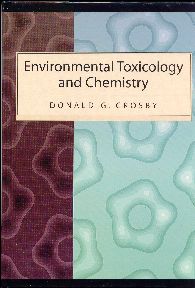
Environmental Toxicology and Chemistry
Oxford University Press, 1998, 336 pages
Donald G. Crosby

|
 nvironmental toxicology is the science of toxic chemicals,
both natural and artificial, in the natural environment. This introductory
book, accessible to any scientifically literate lay reader who has taken a
course in college-level general chemistry and biology, gives a basic
overview of the topic. It's also full of fascinating details that
the average person might not be aware of,
but which are enormously useful at cocktail parties, such as:
nvironmental toxicology is the science of toxic chemicals,
both natural and artificial, in the natural environment. This introductory
book, accessible to any scientifically literate lay reader who has taken a
course in college-level general chemistry and biology, gives a basic
overview of the topic. It's also full of fascinating details that
the average person might not be aware of,
but which are enormously useful at cocktail parties, such as:
The main problem with this book is that it contains many embarrassing misstatements, such as saying that the principal nitrogen compound in the atmosphere is "the relatively inert N2O" (nitrous oxide), that "soil has an overall negative charge", that "elemental chlorine" is used as a biocide, and many others. The example of "alkylation" of ethylene dibromide by hydroxide ion shown on page 87 will seem pretty funny to organic chemists. The author's description of the mechanism of nitrite to treat cyanide poisoning is also completely wrong. Contrary to what the author says, the function of amyl nitrite is to convert some hemoglobin to methemoglobin, which then avidly binds cyanide, preventing it from reaching cytochrome oxidase in cells.
This book is more oriented toward chemistry than other books on the
subject, such as Fundamentals of Ecotoxicology ( )
by M. C. Newman, which concentrates instead on basic principles of pharmacology,
population biology, and radiation and largely omits discussion of biotransformation
and toxic chemicals.
Fundamentals doesn't get much past the most introductory descriptions,
and discusses basic topics that would normally be covered in an introductory
biology course, emphasizing the "eco" much more than the "toxicology".
It seems to be intended as a textbook for a short undergraduate course for
non-science majors. The information is presented from a pro-environmentalist
viewpoint. Almost 100 of its 400 pages are used up by references and a large
glossary.
)
by M. C. Newman, which concentrates instead on basic principles of pharmacology,
population biology, and radiation and largely omits discussion of biotransformation
and toxic chemicals.
Fundamentals doesn't get much past the most introductory descriptions,
and discusses basic topics that would normally be covered in an introductory
biology course, emphasizing the "eco" much more than the "toxicology".
It seems to be intended as a textbook for a short undergraduate course for
non-science majors. The information is presented from a pro-environmentalist
viewpoint. Almost 100 of its 400 pages are used up by references and a large
glossary.
In a field like environmental science, where is is difficult to get definitive answers, skepticism is the only defense against hysterical over-reaction. Environmental Toxicology and Chemistry tries to educate the reader about the need for skepticism. For example, the controversies about the environmental effects of DDT, the banning of which caused a public health disaster, are well described.
Professional toxicologists will probably not learn much new in this book. However, as we discovered in such horrific detail in December 2004, many average people know shockingly little about things in the natural environment that can kill them, whether it is chemicals or tsunamis. Lack of knowledge about environmental chemistry leaves people susceptible to exploitation by special interest groups such as environmentalist groups, and unable to judge the seriousness of real dangers of chemicals in their environment. These people would be well-served to read this book.
